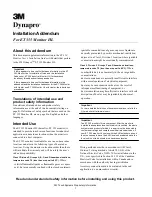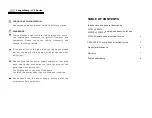
Centripetal Force Accessory
Model No. ME-8089
4
®
Introduction
PASCO’s Computer-Based Centripetal Force Accessory
(ME-8089) allows students to investigate the relationships
between centripetal force, radius, mass, and velocity for
an object undergoing uniform circular motion. Traditional
experiments in this area involve the swinging of masses
above the head. The traditional approach is difficult to
execute and data is rarely sufficient for an understanding
of the relationships. With a computer interface, Force
Sensor, and photogate, the Computer-Based Centripetal
Force Accessory removes these difficulties by allowing
the student to directly measure and observe the force and
velocity of the mass as it rotates.
Masses are included with the apparatus to facilitate a
range of mass trials. The sliding and stationary mass hold-
ers provided with the accessory attach to a PASCO Rotat-
ing Platform (ME-8951). Spinning the Rotating Platform
and allowing it to slow down (without assistance) varies
the velocity. The platform can be manually spun by hand
or automatically with a Motor Drive (ME-8955) and DC power supply. Sliding the captured
masses along the grooves in the rotating platform changes the radius. For radius measurements, a
convenient measuring scale is included on the top edge of the platform.
Equipment Setup
1.
Insert the photogate post into the base
stand and into the photogate head.
2.
Use a thumbscrew to mount a Photogate
Head (ME-9498A) to the bottom of the
“A” base (See Figure 2). Let the Photogate
Head rest over the first ring on the 3-step
pulley of the Rotating Platform. (
Note:
Ensure that the positioning of the
photogate does not restrict movement of
the shaft).
3.
Connect the photogate to a computer
interface (
ScienceWorkshop
or
PASPORT).
Figure 1: Setup with Force
Sensor on Stand
Figure 2: Photogate on Base
of Centripetal Apparatus
photogate
pulley
steel rod
cable
to interface






























